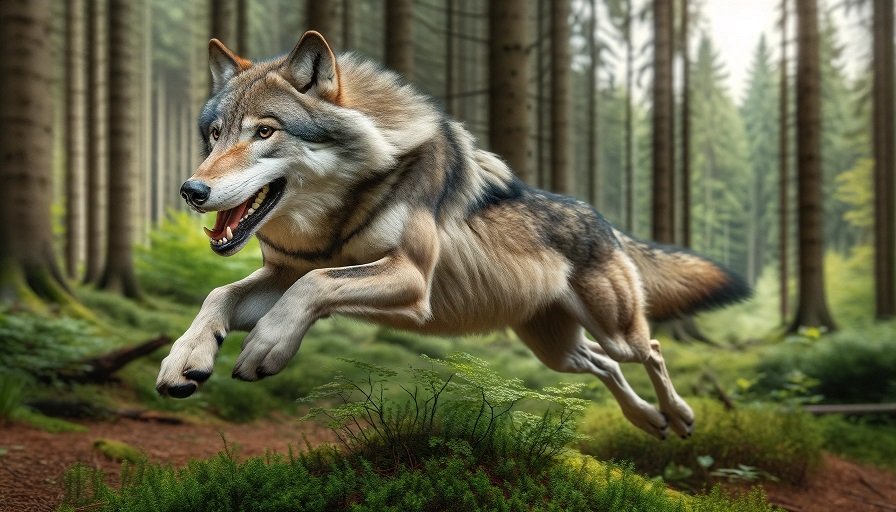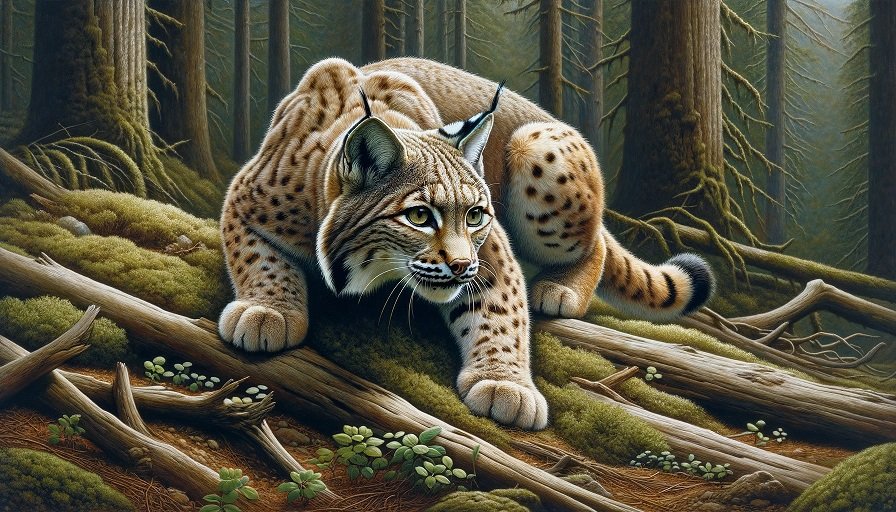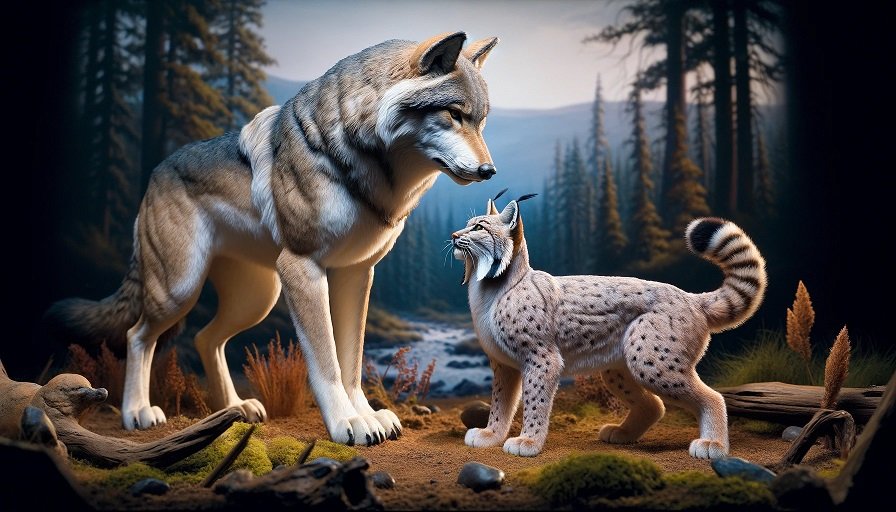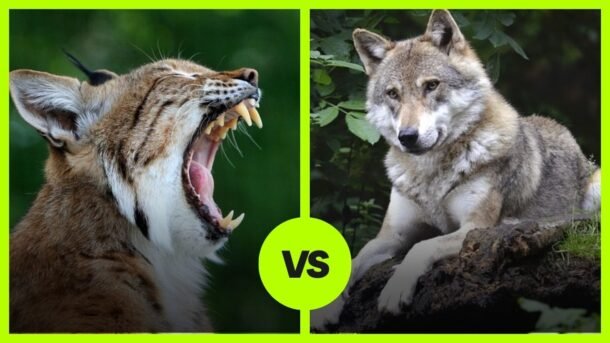Hold onto your seats, because we’re about to explore a face-off between a Grey Wolf and a Bobcat! Can sheer size and power trump agility and stealth? Let’s hash this one out, shall we?
Bite Force and Jaw Strength
Grey Wolf: The bite force of a Grey Wolf is a defining feature in its combat arsenal. With one of the most powerful bites among canids, a wolf’s jaws are engineered to grip, tear, and crush. This formidable bite force, estimated at around 400 pounds per square inch (psi), is not only instrumental in hunting but also a crucial weapon in combat. The strength of a wolf’s jaws means it can inflict deep, debilitating wounds on its opponent, targeting critical areas with precision and force. In a battle, this ability to deliver severe damage with a single bite could be a decisive factor.
Bobcat: The Bobcat, while smaller in size, has a surprisingly potent bite force for its stature. Its bite, estimated at around 200 psi, is powerful enough to penetrate the hide and bones of its prey. In combat scenarios, this strong bite is most effective in a stealth approach, where the bobcat can ambush its opponent and aim for vulnerable spots. The bobcat’s strategy often involves targeting the neck or other critical areas, where a powerful bite can quickly incapacitate an adversary.
Agility and Reflexes

Grey Wolf: Beyond strength, the Grey Wolf’s agility is a significant asset in combat. These predators are capable of quick, nimble movements that aid in both chasing prey and evading attacks. In a confrontation, a wolf can swiftly change direction, dodge attacks, and maintain a tactical advantage over its opponent. This agility, combined with their physical strength, makes wolves versatile combatants, able to adapt their strategy as the fight progresses.
Bobcat: In the realm of agility and reflexes, the Bobcat excels. Its body is built for explosive power, capable of making swift, acrobatic leaps and sudden changes in direction. This agility allows the bobcat to execute complex maneuvers, making it a challenging target to pin down. In combat, this means a bobcat can swiftly evade attacks, reposition itself advantageously, and strike back with precision. This agility is particularly useful in creating and exploiting openings in an opponent’s defense.

Combat Experience and Behavioral Tactics
Grey Wolf: In nature, wolves frequently engage with large, formidable prey and occasionally confront other predators. This experience in dealing with diverse and dangerous adversaries hones their combat skills. Wolves learn to gauge the strength and behavior of opponents, adapting their tactics accordingly. They understand when to press an attack or retreat, making them tactically astute combatants. This experience also imbues them with a resilience and determination crucial in a fight.
Bobcat: While the Bobcat’s combat encounters are different, they are no less significant. As solitary hunters, bobcats rely heavily on stealth and the element of surprise. Their combat style is about efficiency – striking quickly and decisively. Bobcats aim to end a confrontation swiftly, avoiding prolonged physical engagements. This approach reflects their hunting style, where a quick, lethal strike is preferable to a drawn-out battle.
Endurance vs. Burst Speed
Grey Wolf: The endurance of a Grey Wolf is legendary. In the wild, they can travel vast distances in pursuit of prey, a testament to their stamina. This endurance translates well in combat, especially in prolonged engagements where persistence and the ability to outlast an opponent become key. A wolf’s ability to maintain its physical and mental composure over an extended period gives it a significant advantage in drawn-out battles.
Bobcat: Contrasting the wolf’s endurance, the Bobcat’s strength lies in its burst speed. Capable of reaching impressive speeds in short bursts, bobcats use this ability to ambush prey and evade danger. In combat, this translates to a style that relies on speed and surprise. The bobcat’s strategy would likely involve using quick, powerful strikes to gain the upper hand early, aiming to disable its opponent before the fight draws out and its speed advantage diminishes.
Hunting Styles and Prey

Grey Wolf: Wolves hunt in packs, taking down larger prey like deer, elk, and even bison. They employ strategic teamwork, using their numbers and coordination to encircle and tire out their prey.
Bobcat: Bobcats are solitary hunters that rely on stealth. They’re ambush predators, using the element of surprise to get close to their prey, which mostly consists of smaller animals like rabbits, birds, and rodents.
Gray Wolf Hunting Style
Strategic Pack Dynamics: The Grey Wolf’s exceptional strength lies in its pack-based hunting strategy. This is not just about numbers; it’s about strategic coordination and communication, allowing wolves to tackle prey much larger than themselves. Examples from nature include taking down elk or bison, where each wolf plays a specific role, from the lead attacker to the flankers. Even when solitary, a Grey Wolf retains these strategic instincts, making it a calculated and formidable adversary in combat.
Superior Endurance: Grey Wolves are not just sprinters; they’re marathon runners of the animal kingdom. Their ability to travel up to 30 miles a day at a steady trot and burst into high-speed chases sets them apart. In a prolonged conflict, this endurance means a Grey Wolf can outlast its opponent, wearing them down with relentless pressure. This stamina, coupled with their size and strength, makes them exceptional combatants in scenarios where attrition is a factor.
Bobcat’s Refined Assets
Stealth Mastery: The Silent Assassin Bobcats, though smaller than wolves, possess a remarkable ability for stealth. They are the epitome of ambush predators, utilizing their environment for cover and approaching their prey (or opponents) with near silence. In the wild, this translates to successful hunts where the Bobcat can get incredibly close to unsuspecting prey before striking. In a combat scenario, this stealth gives the Bobcat a significant advantage in delivering the first, potentially decisive, blow.
Lethal Claw Strikes: Precision and Power A Bobcat’s retractable claws are not only sharp but are weapons of precision. When they strike, it’s with calculated accuracy, aiming for critical areas to maximize damage. In nature, this is seen when Bobcats target the neck or back of their prey, aiming for a quick and effective kill. In combat, these claws mean that if a Bobcat gets within striking distance, it can deliver a potentially fight-ending blow, leveraging its agility and striking power to target vulnerabilities in its opponent.
Arena: A Mixed Forest with Open Spaces
Both the Grey Wolf and the Bobcat are creatures of the forest, so let’s put this theoretical battle in a forest clearing surrounded by trees and rocks for natural cover.
Prognosis: Winning Percentages
Time for the verdict:
- Grey Wolf: 80%
- Bobcat: 20%
Look, the Bobcat is an agile and wily creature with a talent for ambush, but the Grey Wolf’s size, strength, and stamina are hard to counter. Unless the Bobcat lands a perfect, vital hit early on, the Wolf’s greater physicality will likely overpower it.
For readers interested in exploring more about the fascinating world of animal confrontations, here are three recommended articles from our website:
Dive into the stealthy world of big cats with “Bobcat vs Leopard: A Tale of Two Big Cats from Different Worlds.” This article explores the intriguing differences and similarities between these two skilled predators.
Discover an intense North American predator face-off in “Wolf vs Cougar: A Battle of North American Predators.” This article provides a detailed comparison of the hunting techniques and survival strategies of wolves and cougars.




